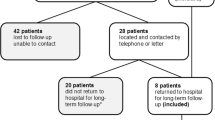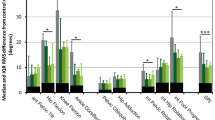Abstract
Background
Multilevel orthopedic surgery is considered to be the gold standard treatment for ambulatory children with cerebral palsy (CP), classified at levels I, II, or III according to the Gross Motor Function Classification System (GMFCS). Hip enlocation and stability are the main goals of orthopedic intervention in the GMFCS level IV subgroup and are well researched; however, there is no evidence to date to support or challenge the effectiveness of orthopedic treatment to preserve functional mobility in this patient group. The aim of this study was to evaluate the results of orthopedic surgery to maintain or restore standing transfers and supported walking in children with CP at GMFCS level IV.
Methods
Twenty-two children with CP GMFCS level IV who underwent orthopedic surgery to improve mobility between the years 2004 and 2008 were included in this study. A retrospective chart review was performed and a satisfaction questionnaire sent to all patients. The primary outcome measure was the attainment and maintenance of mobility goals 2 years post-surgery. The secondary outcome measures were family/patient satisfaction, Functional Mobility Scale (FMS), and complications.
Results
The two goals identified by the patients and carers were standing transfers and supported walking. At the 2-year post-surgery assessment, 14 children (63.6 %) did not reach their pre-determined goals. In the questionnaire, 21.4 % of the families reported that surgery was not beneficial. The FMS score remained unchanged in 95.4 % of the patients. Fourteen patients (63.6 %) had at least one complication that prolonged their post-operative rehabilitation (e.g., neuropraxia).
Conclusion
This study suggests that orthopedic surgery in children with CP at GMFCS level IV is unlikely to maintain or restore mobility. Furthermore, it carries a significant risk of complications.
Level of evidence
Case series, Level IV.


Similar content being viewed by others
References
Stanley F, Blair E, Alberman E (2000) Cerebral palsies: epidemiology and causal pathways. Mac Keith Press, London
Palisano R, Rosenbaum P, Walter S, Russell D, Wood E, Galuppi B (1997) Development and reliability of a system to classify gross motor function in children with cerebral palsy. Dev Med Child Neurol 39(4):214–223
Hanna SE, Rosenbaum PL, Bartlett DJ, Palisano RJ, Walter SD, Avery L et al (2009) Stability and decline in gross motor function among children and youth with cerebral palsy aged 2 to 21 years. Dev Med Child Neurol 51(4):295–302
Beckung E, Carlsson G, Carlsdotter S, Uvebrant P (2007) The natural history of gross motor development in children with cerebral palsy aged 1 to 15 years. Dev Med Child Neurol 49(10):751–756
Palisano RJ, Rosenbaum P, Bartlett D, Livingston MH (2008) Content validity of the expanded and revised Gross Motor Function Classification System. Dev Med Child Neurol 50(10):744–750
Adolfsen SE, Ounpuu S, Bell KJ, DeLuca PA (2007) Kinematic and kinetic outcomes after identical multilevel soft tissue surgery in children with cerebral palsy. J Pediatr Orthop 27(6):658–667
Browne AO, McManus F (1987) One-session surgery for bilateral correction of lower limb deformities in spastic diplegia. J Pediatr Orthop 7(3):259–261
Karol LA (2004) Surgical management of the lower extremity in ambulatory children with cerebral palsy. J Am Acad Orthop Surg 12(3):196–203
Gough M, Eve LC, Robinson RO, Shortland AP (2004) Short-term outcome of multilevel surgical intervention in spastic diplegic cerebral palsy compared with the natural history. Dev Med Child Neurol 46(2):91–97
Rodda JM, Graham HK, Nattrass GR, Galea MP, Baker R, Wolfe R (2006) Correction of severe crouch gait in patients with spastic diplegia with use of multilevel orthopaedic surgery. J Bone Joint Surg Am 88(12):2653–2664
Soo B, Howard JJ, Boyd RN, Reid SM, Lanigan A, Wolfe R et al (2006) Hip displacement in cerebral palsy. J Bone Joint Surg Am 88(1):121–129
Canavese F, Emara K, Sembrano JN, Bialik V, Aiona MD, Sussman MD (2010) Varus derotation osteotomy for the treatment of hip subluxation and dislocation in GMFCS level III to V patients with unilateral hip involvement. Follow-up at skeletal maturity. J Pediatr Orthop 30(4):357–364
Raina P, O’Donnell M, Rosenbaum P, Brehaut J, Walter SD, Russell D et al (2005) The health and well-being of caregivers of children with cerebral palsy. Pediatrics 115(6):e626–e636
Eisenberg S, Zuk L, Carmeli E, Katz-Leurer M (2009) Contribution of stepping while standing to function and secondary conditions among children with cerebral palsy. Pediatr Phys Ther 21(1):79–85
Hough JP, Boyd RN, Keating JL (2010) Systematic review of interventions for low bone mineral density in children with cerebral palsy. Pediatrics 125(3):e670–e678
Cusick A, McIntyre S, Novak I, Lannin N, Lowe K (2006) A comparison of goal attainment scaling and the Canadian Occupational Performance Measure for paediatric rehabilitation research. Pediatr Rehabil 9(2):149–157
Dickinson HO, Parkinson KN, Ravens-Sieberer U, Schirripa G, Thyen U, Arnaud C et al (2007) Self-reported quality of life of 8–12-year-old children with cerebral palsy: a cross-sectional European study. Lancet 369(9580):2171–2178
Harvey A, Graham HK, Morris ME, Baker R, Wolfe R (2007) The Functional Mobility Scale: ability to detect change following single event multilevel surgery. Dev Med Child Neurol 49(8):603–607
Novacheck TF, Stout JL, Tervo R (2000) Reliability and validity of the Gillette Functional Assessment Questionnaire as an outcome measure in children with walking disabilities. J Pediatr Orthop 20(1):75–81
Godwin EM, Spero CR, Nof L, Rosenthal RR, Echternach JL (2009) The gross motor function classification system for cerebral palsy and single-event multilevel surgery: is there a relationship between level of function and intervention over time? J Pediatr Orthop 29(8):910–915
Khan MA (2007) Outcome of single-event multilevel surgery in untreated cerebral palsy in a developing country. J Bone Joint Surg Br 89(8):1088–1091
Graham HK, Harvey A (2007) Assessment of mobility after multi-level surgery for cerebral palsy. J Bone Joint Surg Br 89(8):993–994
Pruitt DW, Tsai T (2009) Common medical comorbidities associated with cerebral palsy. Phys Med Rehabil Clin N Am 20(3):453–467
Damiano DL, Alter KE, Chambers H (2009) New clinical and research trends in lower extremity management for ambulatory children with cerebral palsy. Phys Med Rehabil Clin N Am 20(3):469–491
Lauder GR, White MC (2005) Neuropathic pain following multilevel surgery in children with cerebral palsy: a case series and review. Paediatr Anaesth 15(5):412–420
Karol LA, Chambers C, Popejoy D, Birch JG (2008) Nerve palsy after hamstring lengthening in patients with cerebral palsy. J Pediatr Orthop 28(7):773–776
Stout JL, Gage JR, Schwartz MH, Novacheck TF (2008) Distal femoral extension osteotomy and patellar tendon advancement to treat persistent crouch gait in cerebral palsy. J Bone Joint Surg Am 90(11):2470–2484
Lee KM, Chung CY, Park MS, Lee SH, Choi IH, Cho T-J et al (2010) Level of improvement determined by PODCI is related to parental satisfaction after single-event multilevel surgery in children with cerebral palsy. J Pediatr Orthop 30(4):396–402
Acknowledgments
We would like to acknowledge Joan Tornquist for her help in reviewing and editing the final manuscript, as well as Liz Barnes and Federica Barzi for their assistance with the statistical analysis.
Conflict of interest
None.
Author information
Authors and Affiliations
Corresponding author
About this article
Cite this article
Blumetti, F.C., Wu, J.C.N., Bau, K.V. et al. Orthopedic surgery and mobility goals for children with cerebral palsy GMFCS level IV: what are we setting out to achieve?. J Child Orthop 6, 485–490 (2012). https://doi.org/10.1007/s11832-012-0454-7
Received:
Accepted:
Published:
Issue Date:
DOI: https://doi.org/10.1007/s11832-012-0454-7




